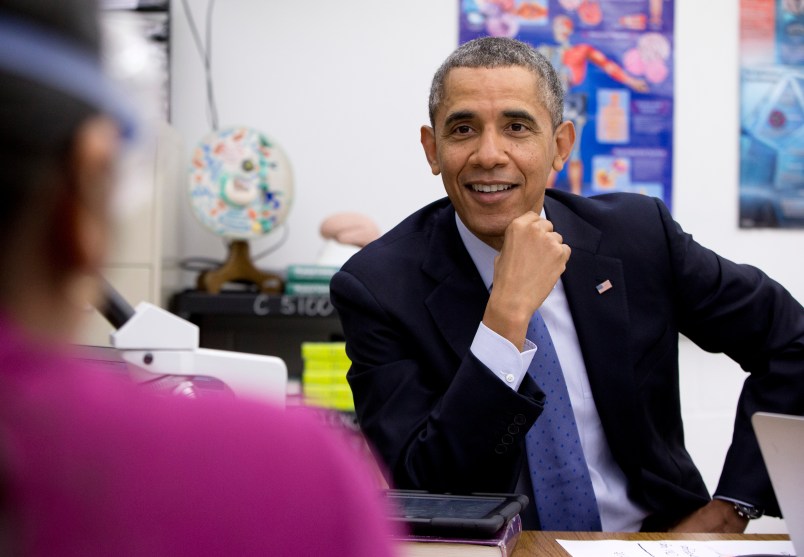A study released Tuesday blows the door wide open in the never-ending parlor game to estimate how many uninsured Americans have gotten health coverage under Obamacare, suggesting that the number might be bigger than previously thought.
But at this point, nobody is quite sure what to make of it.
RAND Corp, a non-profit think tank, released the survey. Its eye-opening finding: 7.2 million previously uninsured people have gained health coverage through their employer since mid-September. That’s on top of those people who have purchased private coverage on Obamacare’s insurance marketplaces or enrolled in Medicaid or young adults who signed up through their parents’ plan.
Those three groups were the only people that many previous estimates of Obamacare’s impact had accounted for.
In other words, if you take the earlier estimates of 8.3 million to 9.5 million uninsured people who had gotten covered by marketplace plans, Medicaid and their parents’ policies — and then add some of the millions more who RAND found had gotten insured through their employer — then Obamacare could be responsible for reducing America’s uninsured ranks much more than the earlier estimates suggested.
“I think that’s fair,” Larry Levitt, vice president of the non-profit, non-partisan Kaiser Family Foundation, told TPM when asked if that was one of the study’s implications. “Some of it could be improvements in the economy, which might have happened regardless of the Affordable Care Act.
“But it could also be tied to the individual mandate as people who previously turned down employer coverage signed up to avoid getting penalized. How big an effect the mandate is having is possibly one of the biggest unknowns right now.”
Now there are a lot of caveats. First, the RAND study is based on a two-part survey of 2,425 U.S. adults ages 18 to 64. So the margin of error for particular findings could move the numbers by a few million people in one direction or another, the authors wrote. For employer-based coverage specifically, the margin of error is plus-or-minus 3.6 million (out of 8.2 million who gained that coverage, 7.2 million of whom were previously uninsured).
Second, the 7.2 million uninsured getting employer-based coverage might not all be attributable to Obamacare. The RAND authors theorized, as Kaiser’s Levitt did, that the law’s individual mandate might be compelling some people to enroll in employer plans. The gains among those people could then be linked to the law.
But, also like Levitt, RAND said some of the uptick might just be the byproduct of an improving economy — people who had been unemployed and uninsured but then got a job. Those gains wouldn’t be the result of Obamacare directly.
Even if you split the 7.2 million number down the middle, though, that would mean millions more people who have gotten covered because of Obamacare’s influence than previously estimated.
Or lastly, as Levitt tweeted, it could just be statistical noise and the study’s findings are anomalies that don’t reflect what’s happening in the real word. No one knows for sure at this point. The RAND survey shows an overall net drop in the number of uninsured of 9.3 million, but it includes lower estimates for private coverage and Medicaid compared to some other projections while leaving out the young-adult figure, estimated to be 3 million by the administration, entirely.
“It’s certainly one of the unique results of what we have,” Katherine Grace Carman, one of the RAND study’s authors, told TPM of the employer coverage result. She declined to comment further on what might be behind the finding.
It’s safe to say that if Obamacare is leading to that significant a surge in employer-based coverage, it’s an impact that few people saw coming. The Congressional Budget Office didn’t anticipate such an increase — its analysis had projected that employer-based coverage would rise by only 1 million from 2013 to 2014.
There is some reason to think that Obamacare’s individual mandate could correspond to an increase in employer-based coverage. About 17 percent of the 150 million-plus people who had the option of getting health insurance through an employer had actually declined that coverage in 2010, according to Kaiser.
Those people now face a penalty under Obamacare if they continue to reject that coverage, which might help explain why they would decide to sign up for an employer plan now. That was the phenomenon suggested by RAND and Levitt.
It’s simply impossible to know for sure what the law’s exact impact has been, though, especially when some of that increase found by RAND might have been caused instead by the improving economy.
But if RAND has caught onto a trend that previous Obamacare analysis had missed, then the universe of people whom the law is covering just got bigger.






